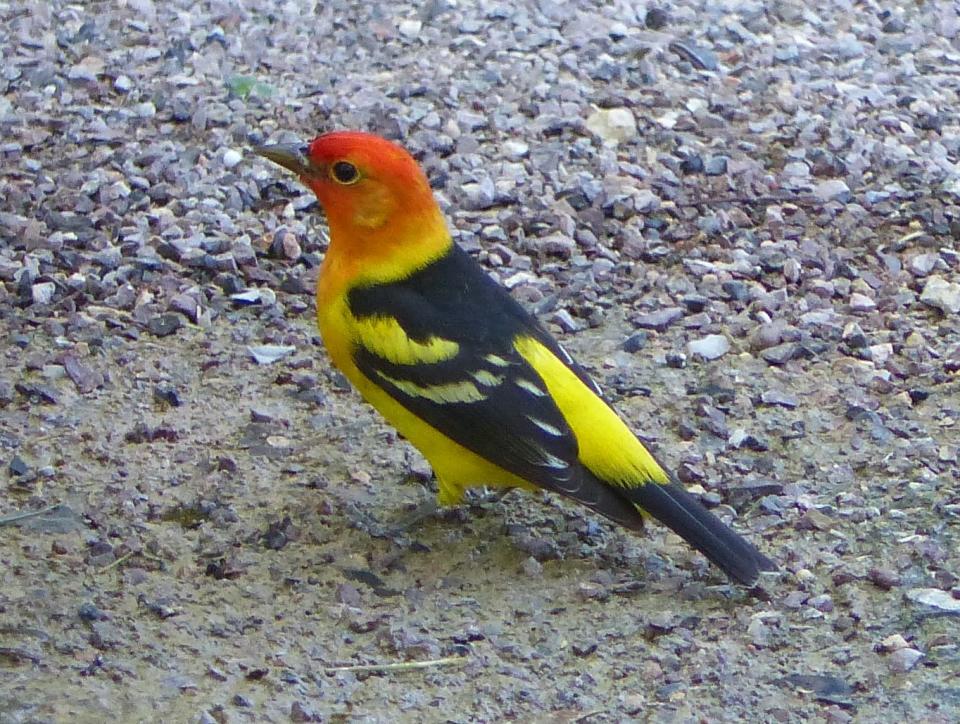Colorful songbirds move through on southbound migration
To many of us in southern New Mexico, late August means that the kids are back in school and the scent of roasting chile is in the air, but these waning days of summer also herald the passage of some of the most colorful birds on the continent. Collectively these birds are known as neotropical migrants – that is, they migrate back and forth each year between their nesting areas in various parts of the U.S. and Canada and their wintering grounds in the Central and South American tropics.
These long-distance travelers include many shorebirds, raptors, and hummingbirds, but undoubtedly among the most spectacularly colored are some of the songbirds, a number of which are moving through our area now and might be spotted over the next several weeks. These birds may also pass through in spring as they head back northward again, but then are usually in a hurry to get to their breeding grounds and don’t tend to linger as they often do on their fall trip.
Especially eye-popping are the orioles – Bullock’s, Scott’s, and hooded; the grosbeaks – blue and black-headed; the tanagers – summer, western, and hepatic; the buntings – painted, indigo, and lazuli; and a veritable bouquet of different warblers. Some of these, such as the orange and black Bullock’s oriole and its bright yellow and black cousin, Scott’s oriole, also breed here so are present for several months, whereas others just use our oasis in the desert as a waystation along their migratory route. All are perhaps most numerous in natural areas, where insects are the main item on the menu, but our gardens and well-planted landscapes – particularly those featuring birdbaths – can often draw these feathered beauties in for a closer look as well.
Red doesn’t get much redder than in the plumage of a male summer tanager, a bird that breeds all across the southern U.S., including here in the Mesilla Valley, and winters as far south as Brazil. Its widespread cousin of mountain conifer forests, the western tanager, is just as strikingly colored. Both tanagers favor wasps and bees, and this time of year can often be seen foraging near blooming Texas-sage shrubs that attract all manner of flying insects.

The male painted bunting is essentially a feathered rainbow. The birds nest locally in small numbers, but unlike many of the other neotropical migrants that stick to places with mature trees they prefer weedy thickets in more open areas, such as irrigation ditches, where they can feed on both insects and plentiful weed seeds. The females are lime green and the youngsters drab brownish, so gender and age make a huge difference in this species! A great place to look for them over the next month or so is behind Las Cruces Dam, especially the weedy ditch banks and arroyo mouths.
More Naturally Speaking:
And then there’s the more passive way of enjoying the spectacle: put out a shallow birdbath, make sure to clean it regularly, add a dripper so that the sound will entice thirsty migrants to investigate, and pull up a chair by the window. It may take some time, but once discovered your birdbath will provide endless hours of entertainment – and particularly during times of drought may offer an important lifeline to these intrepid, long-distance travelers.
Marcy Scott is a local birder, botanizer, and author of "Hummingbird Plants of the Southwest." Along with her husband, Jimmy Zabriskie, she operates Robledo Vista Nursery in the North Valley, www.robledovista.com, specializing in native and adapted plants for birds and wildlife habitat. She can be reached at HummingbirdPlantsSW@gmail.com.
This article originally appeared on Las Cruces Sun-News: Colorful songbirds move through on southbound migration

